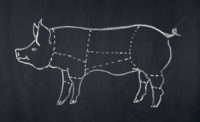Left vs. right: fresh bellies and bilateral symmetry
Effects of bilateral symmetry on fresh belly characteristics of finishing pigs fed high protein canola meal or conventional canola meal.




One hundred forty bellies from 70 pork carcasses (from both barrows and gilts) were obtained from the University of Illinois Meat Science Laboratory. Left and right sides of each carcass were fabricated to comply with Institutional Meat Purchase Specifications (IMPS) as described by the North American Meat Processors Association (2010).
Whole bellies had the spareribs and teat line removed, and flank end squared to meet the specifications of an IMPS #408 belly. Dimensional characteristics (length, width and thickness) and flop distance were measured on each belly. A fat tissue sample containing all three fat layers was collected from the dorsal edge of the anterior end of each belly and used to determine fatty acid profiles. Fresh bellies were skinned using a hand-held skinner and weighed to determine green weight. Data between left- and right-side bellies originating from the same carcass were compared using the paired option of the PROC T Test in SAS.
Several fresh belly characteristics differed between bellies originating from the left and right side of a single pork carcass.
Bellies from the left side of the carcass (4.99 kg) weighed 0.37 kg less (P<0.0001) than bellies from the right side of the carcass (5.36 kg). Weight differences are not likely due to fabrication because teat line trimming was standardized to minimize variation due to carcass splitting, and belly thickness differed in 6 of 8 evaluated locations. Belly width was 7.0 percent less (P<0.0001), average thickness was 6.5 percent less (P<0.0001), flop distance was 13.9 percent less (P<0.0001), and durometer (greater durometer scores indicate greater fat firmness) scores were 5.1 percent less (P = 0.05) in left-side bellies compared with right-side bellies.
Total SFA, total PUFA, UFA:SFA, and iodine value (calculated with two methods; AOCS, 1998; Meadus et al., 2010) were not different (P ≥ 0.36) in left- and right-side bellies. Left- and right-side bellies originating from the same carcasses differed in some individual fatty acids, but overall iodine value was unaffected by side of origin.
These data indicated that bellies originating from the same carcasses differed in weight, width, flop distance and thickness, but had similar fatty acid profiles.
When conducting research on fresh belly characteristics, differences in bilateral symmetry of left- and right-side bellies originating from the same carcass should be considered.
From: Effects of feeding high protein or conventional canola meal on dry cured and conventionally cured bacon
Kelsey L. Little, Benjamin M. Bohrer, Hans H. Stein, Dustin D. Boler. Effects of feeding high protein or conventional canola meal on dry cured and conventionally cured bacon. Meat Science. 103(5), 28-38.
Looking for a reprint of this article?
From high-res PDFs to custom plaques, order your copy today!





